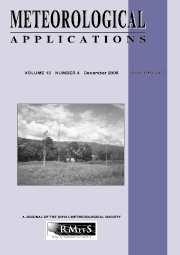Article contents
Prediction of hoar-frost by use of a Road Weather information System
Published online by Cambridge University Press: 18 April 2001
Abstract
This study measured the amount of hoar-frost on the road surface with thehelp of copper plates. The amounts were compared to data collected at astation in the Road Weather information System (RWiS) together withadditional measurements of the temperature and humidity profile abovethe road surface. The data were used to specify the weather parameterswhen hoar-frost forms on the road surface and relate the measured amountof hoar-frost and resulting friction to measured weather parameters. Theaim was also to see whether there was an increased possibility of predictingthe amount of hoar-frost with additional measurements of the temperatureand humidity profiles. The results of this study confirm that the amountof hoar-frost deposited on the road surface increases with increasingaverage wind speed, increasing maximum difference between dew point(Td) and road surface temperature (Tr) and increased duration when Tr < Td,measured at the RWiS station. However, the difference between Td and Trfailed to indicate hoar-frost on several occasions due to the location andpoor accuracy of the measuring equipment. Measurements of temperature andhumidity in a profile up to 2.5 m above the road surface showed that theair layer up to 0.4 m reflected conditions at the road surface whereas thesurrounding areas influenced the measurements at higher levels. A forwardmultiple regression performed on the data showed that measurements oftemperature and humidity at lower levels improved predictions ofdeposition of hoar-frost on the road surface. Measurements of frictionon the road surface when hoar-frost was present showed that frictiondecreased with increasing difference between Td and Tr and it alsoincreased with the duration of Tr < Td. There was no correlation betweenthe amount of hoar-frost and friction at the road surface. The frictionis probably influenced not only by the amount of hoar-frost but also bythe structure of the hoar-frost, which has not been determined in thisstudy.
Information
- Type
- Research Article
- Information
- Copyright
- © 2001 Royal Meterological Society
- 22
- Cited by

